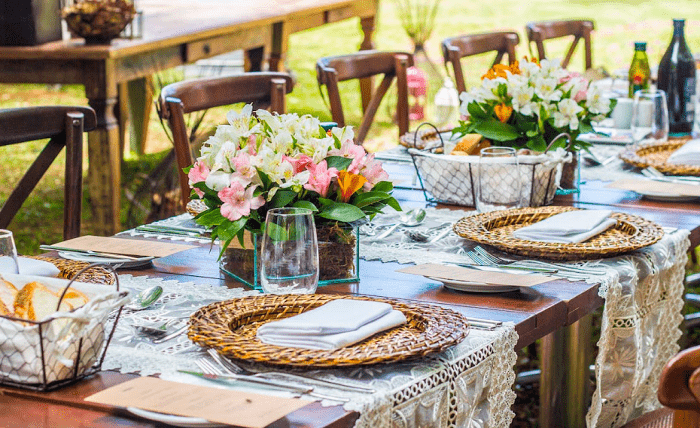I. Introduction
A. Recognizing the Importance of Catering on a Budget
On your special day, it’s crucial to recognize the significance of every aspect, including catering, especially when working within a budget. While the temptation to indulge in lavish spreads may be strong, it’s prudent to balance extravagance with fiscal responsibility. This approach ensures that your guests enjoy a memorable dining experience without breaking the bank. Similarly, when it comes to immortalizing these cherished moments, such as through Texas wedding videography, investing in professional services ensures that every precious moment is captured flawlessly, preserving memories that will last a lifetime.
II. Setting the Catering Budget
A. Establishing Financial Parameters
Before delving into the specifics of catering options, couples must first establish clear financial parameters. This involves determining how much of the overall wedding budget can be allocated to catering expenses. By setting a realistic budget upfront, couples can avoid overspending and better prioritize their expenditures. Additionally, having a clear understanding of financial constraints enables couples to make informed decisions and negotiate effectively with caterers.
B. Determining Guest Count and Menu Preferences
Another crucial aspect of setting the catering budget is determining the guest count and menu preferences. The number of guests will significantly impact the overall cost, as caterers typically charge per person. Couples should carefully consider their guest list and make adjustments as needed to align with their budget. Additionally, discussing menu preferences early on can help caterers provide tailored options that meet both budgetary and culinary requirements.
III. Exploring Budget-Friendly Options
A. Buffet vs. Plated Service
When it comes to catering, couples often have to choose between buffet-style and plated service. While plated service may exude a more formal ambiance, buffets are generally more cost-effective. Buffet-style catering eliminates the need for individual plating and allows guests to serve themselves, reducing staffing requirements and associated costs. However, couples should consider their wedding theme and guest preferences when deciding between the two options.
B. Considering Alternative Catering Styles
In addition to traditional buffet and plated service, couples can explore alternative catering styles to save costs. Food stations, for example, offer a casual yet interactive dining experience and can be more budget-friendly than plated meals. Similarly, family-style dining, where large platters of food are placed on tables for guests to share, can promote a sense of community while minimizing catering expenses. By thinking outside the box and considering alternative catering styles, couples can find creative solutions that align with their budgetary constraints.
IV. Menu Planning
A. Selecting Affordable Yet Delicious Options
Menu planning plays a crucial role in managing catering costs without compromising on taste. Couples should work closely with their caterers to select affordable yet delicious options that cater to a variety of dietary preferences. Opting for seasonal and locally sourced ingredients can not only enhance the flavor of dishes but also reduce costs, as these ingredients are often more readily available and less expensive. Additionally, incorporating versatile ingredients that can be used across multiple dishes can help maximize value and minimize waste.
B. Incorporating Seasonal and Local Ingredients
Seasonal and local ingredients not only add freshness and flavor to dishes but can also contribute to cost savings. By selecting ingredients that are in season and sourced locally, couples can take advantage of lower prices and support local farmers and producers. Seasonal produce, in particular, tends to be more abundant and affordable, allowing couples to create diverse and flavorful menus without exceeding their budget. Furthermore, embracing regional cuisine and incorporating local flavors can add a unique and personal touch to the dining experience.
V. Creative Cost-Saving Measures
A. DIY Elements and Self-Catering Options
For couples looking to further reduce catering expenses, incorporating DIY elements and self-catering options can be a viable solution. DIY appetizers, desserts, and beverages allow couples to personalize their menu while saving on catering costs. Additionally, self-catering certain aspects of the wedding, such as cocktails or late-night snacks, can help stretch the budget without sacrificing quality. However, it’s essential to consider logistical challenges and enlist the help of friends and family to ensure smooth execution.
B. Negotiating with Caterers and Maximizing Value
Negotiating with caterers and maximizing value is another effective way to manage catering costs. Couples should be transparent about their budget constraints and discuss options for customizing packages or reducing expenses without compromising on quality. Additionally, exploring potential discounts or incentives, such as off-peak pricing or bundled services, can help couples secure the best value for their money. By being proactive and assertive in negotiations, couples can make the most of their catering budget and ensure a memorable dining experience for their guests.
VI. Conclusion
In conclusion, planning a budget-friendly wedding catering menu requires careful consideration and strategic decision-making. By setting clear financial parameters, exploring cost-effective catering options, and prioritizing value, couples can delight their guests without overspending. From menu planning to negotiating with caterers, there are numerous strategies available to help couples manage costs while still creating a memorable dining experience. By taking a thoughtful and proactive approach to catering on a budget, couples can ensure that their wedding day is both memorable and financially responsible.


